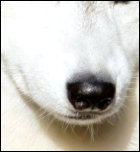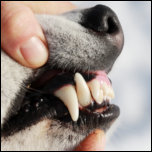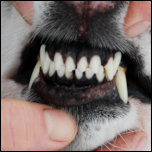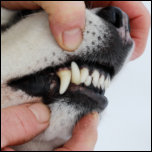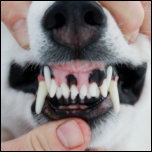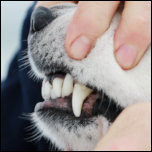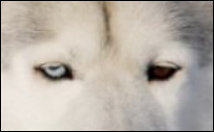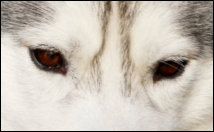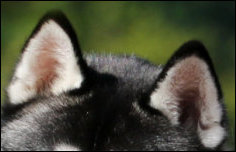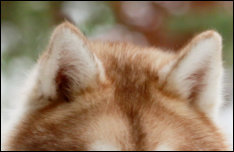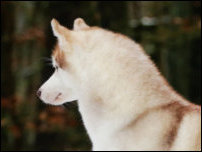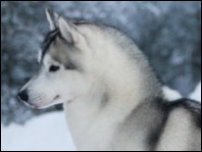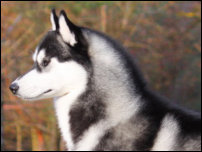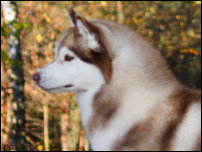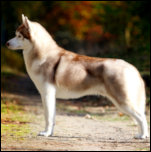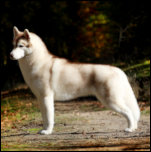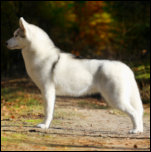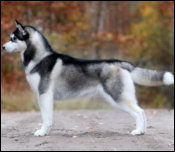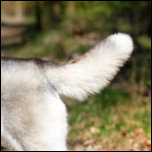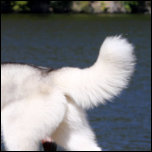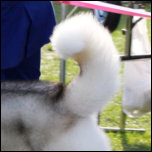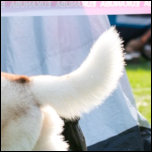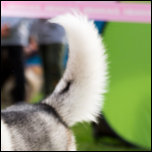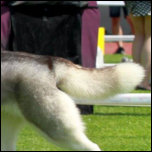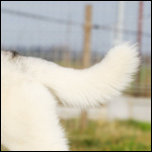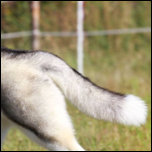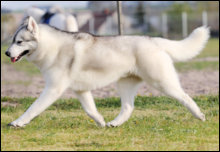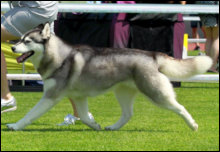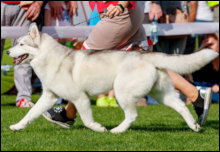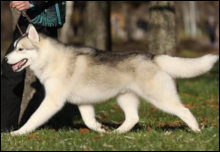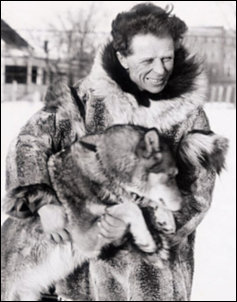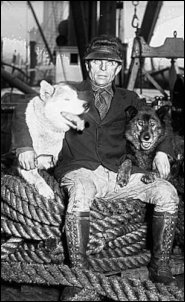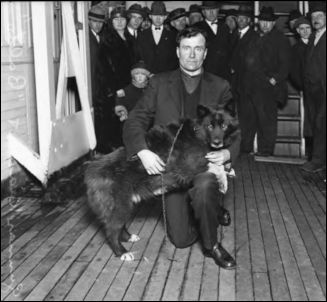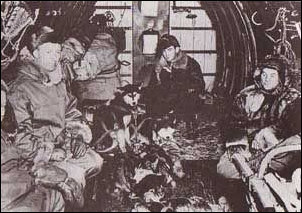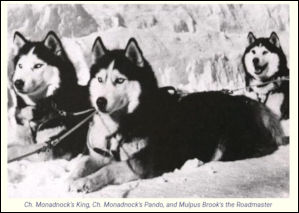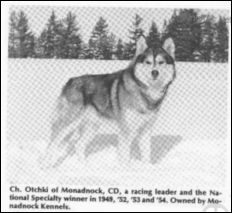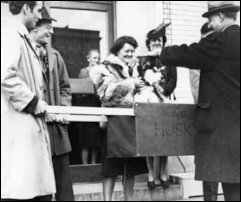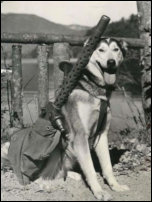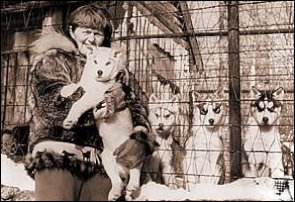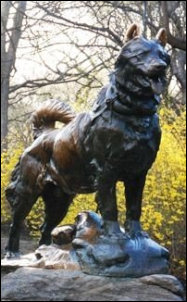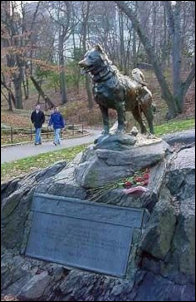Winter Melody
ABOUT SIBERIAN HUSKY
THE SIBERIAN HUSKY STANDARD
ORIGIN: U.S.A.
IMPORTANT PROPORTIONS: height of the
body from the ground to the top of the withers.
BEHAVIOUR / TEMPERAMENT: The characteristic
temperament of the Siberian Husky is friendly and gentle, but also
HEAD
The bridge of the
nose is straight from the stop to the tip.
EYES: Almond shaped, moderately spaced and set a trifle obliquely. Eyes may be brown or blue in colour; one of each or particoloured
are acceptable.
EARS: Of medium size, triangular in shape, close fitting and set
high on the head. They are thick, well furred, slightly arched at the
NECK: Medium in length, arched and carried proudly erect when
dog is standing. When moving at a trot, the neck is extended so that
BODY: The ribs are well sprung from the spine but flattened on the sides to allow for freedom of action.
TAIL: The well furred tail of fox-brush shape is set on just below
the level of the topline, and is usually carried over the back in a nor does it snap flat against the back. A trailing tail is normal for the dog when in repose. Hair on the tail is of medium length and approximately the same
LIMBS Pastern joint: Strong, but flexible.
HINDQUARTERS: When standing and viewed from the rear, the hind legs are moderately spaced and parallel. Dewclaws, if any, are
to be removed. The pads are
tough and thickly cushioned. The paws neither turn in nor out when
GAIT / MOVEMENT: The Siberian Husky’s characteristic gait is
smooth and seemingly effortless. He is quick and light on his feet,
COAT
Colour: All colours from black to pure white are allowed. A variety
of markings on the head is common, including many striking patterns
black - white red-white light red - white
grey - white mostly black ("Sachem's Dream") agouti ("Velnio Malunas")
red - white ("Velnio Malunas")
SIZE AND WEIGHT:
SUMMARY: The most important breed characteristics of the
Siberian Husky are medium size, moderate bone, well balanced
FAULTS : Any departure from the foregoing points should be
considered a fault and the seriousness with which the fault should be
DISQUALIFYING FAULTS:
***
Siberian Husky DON'T move like German Shepherd, Afghan Hound or Bracco Italiano, Siberian husky is moving at a balanced trot. This gait requires the reach of the front legs to equal the drive of the back legs while the topline remains firm and level. Siberian husky is a working breed and everything whats written in the breed standard leads it to it's fit for function. It is sad to see so many post with photos of Siberian Husky in motion, that clearly show the breed representatives not moving correctly, but it is absolutely terrifying to read the author’s statements "I love this movement", "Fantastic mover" and then to see comments of other breeders who agree with the words using OMG what a movement, WOW, fantastic... Siberian Husky gait described in the Standard of the breed: "The Siberian Husky’s characteristic gait is smooth and seemingly effortless. He is quick and light on his feet, and when in the show ring should be gaited on a loose lead at a moderately fast trot, exhibiting good reach in the forequarters and good drive in
*** Siberian husky tail as described in the standard is "well furred tail of fox-brush shape is set on just below the level of the topline, and is usually carried over the back in a graceful sickle curve when the dog is at attention. When carried up, the tail does not curl to either side of the body, nor does it snap flat against the back. A trailing tail is normal for the dog when in repose. Hair on the tail is of medium length and approximately the same length on top, sides and bottom, giving the appearance of a round brush". Faults indicated in the standard are: "a snapped or tightly curled tail, highly plumed tail, tail set too low or too high"
what's behind the coat - here is the example of how important it is to put your hands-on the dog while judging. It is an 9 year old female, that has been doing great both in a show rings and in the harness.
The Siberian Husky a Brief History
Imported to Nome, Alaska by the Russian fur trader William Goosak, the team of Siberians was to be entered in the 1909 All Alaska Sweepstakes race of 408 miles with its $10,000 first prize. No one was impressed with Goosak's little dogs, weighing only 40 to 52 pounds, much smaller compared to their longer legged, heavier competitors. The people of Nome referred to the imports as "Siberian Rats."
Siberian Huskies have taken top honors in many races in the ensuing years, but their first race run on American soil will always remain, by far, their most important. Goosak persuaded Louis Thurstrop, a Danish sailor, to drive his team. This team, even though the odds were 100 to 1 against it in the betting, made a tremendous showing and nearly won the race, placing third. Rumor ran rampant in Nome that gamblers had paid off the driver before he reached the finish in order to save them from ruin. It was said that had Thurstrop won, it would have broken the Bank of Nome.
On the strength of their showing of speed and, particularly, endurance under the most trying conditions, Fox Maule Ramsay, a young Scotsman then in Nome and a competitor himself in the 1909 race, went to Siberia in the summer of 1909. Travelling up the Anadyr River to the trading settlement of Markovo, Ramsay procured around 60 of the best specimens of the breed he could find. He entered three teams of Siberians in the 1910 All Alaska Sweepstakes race, one for each of his uncles and one he drove himself. The team entered in the name of Col. Charles Ramsay and driven by John "Iron Man" Johnson, a Swedish Finn, came in first with an elapsed time of 74 hours, 14 minutes, 37 seconds, the best ever time for the 408 mile race held annually through 1917. Fox Ramsay came in second. The third Siberian team, entered for Col. Stuart and driven by Charles Johnson, placed 4th. (The 75th anniversary All Alaska Sweepstakes race was held in 1983, following the same trail and rules as the original race. The winner was 5 time Iditarod champion Rick Swenson. His time was over 10 hours slower than Iron Man Johnson's 1910 winning time.)
The Siberians attained enormous popularity as racing dogs and the amusement prior to the 1910 race turned to admiration. Although Ramsay's dogs and their progeny went on to win many races through the years, it was Goosak's team of stoic little aliens who set the stage for the importation of the greatest of northern racing breeds, the Siberian dog, later to be known as the Siberian Husky.
In 1913, Roald Amundsen, the Norwegian explorer who was the first man to reach the South Pole, began planning an expedition to the North Pole for 1914. His friend, Jafet Lindberg, also a Norwegian, and co-owner of the largest mining company in Nome, offered to buy and train the dogs for Amundsen. From all over the Seward Peninsula, the best Siberians were selected and purchased. This group of sled dogs was turned over to Leonhard Seppala, an employee of Lindberg's and a fellow Norwegian, to be trained for the upcoming expedition. In 1914 Amundsen gave up his North Pole trek due to the start of World War I. Seppala, with the encouragement of the Pioneer Mining Company, continued to train the Siberians, entering them in the last four Sweepstakes races, winning the last three - 1915, 1916, and 1917. The United States entry in World War I ended the great race series.
In January 1925, Nome was gripped in a spreading diphtheria epidemic. The closest life-saving serum was over 600 miles away, so a dog team relay was formed to hasten its arrival. Seppala left Nome eastbound with 20 Siberians to meet the serum in Nulato, over 300 miles away on the Yukon River. Due to increased urgency for the medicine, the dog team relay continued west beyond Nulato and Seppala met a team carrying the serum package on the eastern shore of Norton Sound. In spite of already having run all day, and in the midst of a blizzard, Seppala turned his tired team around and, with his great leader Togo, made the perilous run back across the Sound to Golovin. A team led by Balto, and driven by Gunnar Kaasen, completed the last leg of the relay. A statue of Balto stands in New York's Central Park, honoring all of the sled dogs of the Serum Run.
Leonhard Seppala withTogo and Fitz Gunner Kaason and Balto Property of Museum of History & Industry, Seattle
As a result of his heroism in the Serum Run, Leonhard Seppala was invited to tour several cities in the lower 48 in the fall of 1926. Leaving Nome with over 40 Siberian Huskies, including Togo, Seppala traveled from west to east, stopping in Seattle, Kansas City, Dayton, Detroit, and Providence, before finally visiting New York City. There, at Madison Square Garden, Togo was presented a medal by the explorer Roald Amundsen, for his role in the serum relay. After his tour, in December 1926, Seppala went to New England and was hosted by Arthur Walden of Wonalancet, New Hampshire. Walden, a former Klondike gold seeker, had been winning many of the races in the up and growing New England/Eastern Canada sled dog races with his line of sled dogs based on Chinook, his large, yellow, mixed breed dog.
Seppala entered his Siberians in a race at Poland Spring, Maine in January 1927. In a repeat of the breed's introduction in Nome, the New Englanders looked upon the Siberians with pity. Once again, they were dwarfed by the huge New England dogs, and it came as a surprise to all except Seppala when the Siberians easily won their first race outside Alaska, beating Walden's team by over seven minutes over the 25 mile course.
Two weeks later, Seppala won the more prestigious New England Point To Point 3 day race near Laconia. It was apparent that the Siberians were superior to the local racing dogs, and many mushers were anxious to acquire them. Seppala, in partnership with Elizabeth Ricker, a New England musher and afficionado of the Siberian, established a kennel at Poland Spring, Maine. Seppala came from Alaska each fall to New England and raced the Siberians, amassing more wins and records across the area than any other musher. His last year of racing in the lower 48, 1932, included the Winter Olympics at Lake Placid, New York, where sled dog racing was staged as a demonstration sport.
The Seppala/Ricker kennel closed in 1931 after many mushers had acquired Siberians from it, and Seppala returned to Alaska for good in 1932, leaving his remaining Siberians with Harry Wheeler, owner of the Gray Rocks Inn in St. Jovite, Quebec. Wheeler established his famous kennel, with the suffix "of Seppala," and provided many more fine Siberians to mushers and kennels during the 1930's. Wheeler himself continued to race the Siberians and win several big races, including Laconia and Québec City. All the registered dogs of today can trace their ancestry to the dogs from the Seppala-Ricker kennel or Harry Wheeler's kennel.
The dogs that Goosak brought to Nome in 1908 varied considerably in phenotype. Some were long and leggy, others shorter coupled and heavier boned, some marked symmetrically, some not. Indigenous Siberian breeders used performance as the only criterion-aesthetics did not enter the picture. Seppala, although obviously concerned with function, had already begun breeding with an eye to greater uniformity. The breed was officially recognized by the American Kennel Club in 1930, and the first standard was published in the AKC Gazette in April 1932. The degree to which the basic tenets of the original 1930 Standard have survived five revisions indicates the kind of in-depth study that went into its composition.
Monadnock huskies
Of the many early foundation kennels in New England, Eva "Short" Seeley's Chinook Kennel and Lorna Demidoff's Monadnock Kennel were the most successful in demonstrating the concept of a dual purpose Siberian, one who could win in the show ring as well as on the trail. Too often today, one hears the argument of show dogs versus sled dogs and forgets that not only did Chinook and Monadnock produce the foundation stock for almost every show kennel in the country after World War II, but they also fielded some of the top racing teams of their day and the teams they drove contained many bench show champions, many of them outstanding leaders. (Most Siberian sled dogs were used by the Army during World War II for arctic search and rescue. After a half decade hiatus for the War and the end of the depression, the breed became ever more popular and the interest in sled dog racing spread.)
Chinook Seeley husky
There was no one actually breeding pure Siberians in Alaska in 1946 when Natalie Jubin arrived with two AKC registered Siberians bred by Eva "Short" Seeley of Chinook Kennels in New Hampshire. One of these, Chinook's Alladin of Alyeska, became the foundation stud of today's oldest Siberian kennel--Alaskan Kennels, owned by Earl and Natalie Norris. An Alladin grandson, Ch. Bonzo of Anadyr, CD, became the first Siberian Husky to win Best In Show at an AKC all breed show (1955). Bonzo was the Norris's main leader from 1954 to 1960. Another Alladin grandson, Ch. Tyndrum's Olso, CD led Kit MacInnes to both the Women's Alaskan and the Women's North American championships, and a 2nd at the open Rondy. Both dogs are prominently featured in Alaska and in sled dog books for their racing and leadership qualities more than their other achievements.
This dual purpose concept was successfully continued into the 1960s and 1970s by Charlie and Carolyn Posey's Yeso Pac Kennel. Earl and Natalie continue to field an all-Siberian team for the Iditarod, as they have done in almost every Iditarod Trail sled dog race since its inception in 1973. Earl himself raced in 1985 and 1986 and Martin Buser ran Anadyr dogs in 1980 and 1981.
Balto statues in New York City
Excerpts: The Siberian Husky, ISHC; Brief History of the Siberian Husky in Alaska, Natalie and Earl Norris; and The Complete Siberian Husky, Lorna Demidoff and Michael Jennings
The breief history is coming from Siberian Husky Club Of America www.shca.org
*** So… You Want A Siberian Husky?
Are you interested in buying a Siberian Husky? Then, you've already heard how marvelous they are. We think you should also be told that they do have their shortcomings, and may not make the ideal pet for everyone who is attracted to them. Siberians are a gregarious lot and need the company of other dogs or of people at all times. If you work all day, or have room for only one dog . . . don't buy a Siberian.
While capable of strong affection for his family, the Siberian Husky is also very friendly with strangers. So, if you want the fierce loyalty of a one-man dog . . . don't buy a Siberian.
The Siberian Husky is not a watch dog, although those ignorant of his true nature may be frightened by his appearance. If you want a dog with aggressive guard-dog instincts . . . don't buy a Siberian.
At least once a year Siberians shed their coats. If you like fur all over the house and in the very air you breathe, then fine. If, however, you value neatness at all times, then . . . don't buy a Siberian.
Siberian Huskies have a natural proclivity for digging holes in backyards. If you take great pride in your landscaping efforts . . . don't buy a Siberian.
Of all the shortcomings to be found in Siberians, the most dangerous to the pet owner is their tremendous desire to RUN. But the very first dash that a puppy makes across the road could be his last run, anywhere. A Siberian, for his own protection, should be kept confined or under control at all times. If you are one of those people who think it is cruel to kennel a dog, or keep him confined in his own backyard . . . don't buy a Siberian.
We just happen to believe that any dog is better off in a proper kennel than running loose all over the countryside. Yes, a kennel dog is missing a lot in life: the chance to be hit by a car; the fun of being dirty, full of burrs, and loaded with worms; the opportunity of being attacked by other dogs; the joy of being sick on garbage infested with disease; the pleasure of being tormented by mean kids; the thrill of being shot in a farmyard; and finally the great comfort of never knowing where he belongs or how to behave. We don't want to see any Siberian become a TRAMP.
If you have read this far, honestly feel that you qualify on all counts, and are still determined to own a Siberian, then we take great pleasure in welcoming you to the fold. Join the rest of us in the smug complacency of knowing that we own the most beautiful, the smartest, the most nearly ideal dog in the world . . . the SIBERIAN HUSKY!
Source: So ... you want a Siberian Husky is coming from Siberian Husky Club Of America www.shca.org
*** Siberian Husky - health
EYE DISEASES
There are many possible eye defects in dogs, but only three are of current concern in th Siberian. They can occur in any eye color, the current information has not yet verify the mode of genetic inheritance for every eye disorder, and in some cases they may be environmentally influenced. Hereditary or juvenile cataracts, corneal dystrophy, and progressive retinal atrophy, each disorder is present in a different portion of the eye.
PRA (Progressive Retinal Atrophy) - is a degenerative disease of the retina that ultimately leads to loss of vision. The retina is the neurosensory structure in the back of the eye that transmits images to the brain. In one of the most common form of PRA called prcd-PRA (progressive rod-cone degeneration), the rods degenerate first leading to a loss in night vision followed by the cones with a loss of day vision. The Siberian Husky has a unique type of PRA that is only found in Siberians and man. This type of PRA is called XLPRA (X Linked PRA) since it is transmitted through the "XX" chromosome of the female. It will cause a loss of night vision followed by a loss of day vision, eventually blindness. The recessive gene for XLPRA is situated on the "X" chromosome of the female. Females who inherit a defective gene on the "X" chromosome from one parent and a normal gene on the other "X" chromosome from the other parent, will not be seriously affected. They will be carriers with very subtle retinal defects and no loss of vision. The male puppy from a carrier dam will receive either a defective gene or a normal gene, depending on what chromosome was copied in the DNA replication. If he has the defective gene, the dog will be affected with PRA since males carry an "XY" chromosome. The disease in males can be devastating with loss of vision as early as 5 months of age.
CORNEAL DYSTROPHY - Corneal dystrophy is a term used to describe several conditions that occur in dogs and cause the corneas to become opaque. There are three major categories of corneal dystrophy: epithelial, stromal, and endothelial. Each is named by the anatomic location of the abnormal tissue and opacity.
source: ACVO, ECVO, Siberian Husky Club of Amcerica www.shca.org
HIP DYSPLASIA
Canine Hip Dysplasia typically develops because of an abnormally developed hip joint, but can also be caused by cartilage damage from a traumatic fracture.severe hip dysplasia With cartilage damage or a hip joint that isn’t formed properly, over time the existing cartilage will lose its thickness and elasticity. This breakdown of the cartilage will eventually result in pain with any joint movement. No one can predict when or even if a dysplastic dog will start showing clinical signs of lameness due to pain. The severity of the disease can be affected by environmental factors, such as caloric intake or level of exercise. There are a number of dysplastic dogs with severe arthritis that run, jump, and play as if nothing is wrong and some dogs with barely any arthritic x-ray evidence that are severely lame.
source: OFA www.ofa.org
ECTOPIC URETERS
Ectopic ureters are a physical defect in one or both of the ureters, which are the small tubes that travel from the kidneys to the bladder. Urine flows from the kidney into the bladder through these ureters, but sometimes one or both do not lead all the way to the bladder, so they bring urine wherever they do lead, which may be the uterus, vagina, or urethra. Because these other organs are unable to handle the storage of urine, this causes leakage, infection, and irritation of the urinary and reproductive system. The hereditary nature of Ectopic Ureter has not yet been proven.
EPILEPSY:
Epilepsy is the most common neurological disorder seen in dogs, and has been estimated to affect approximately 0.75% of the canine population3. The term epilepsy refers to a heterogeneous disease that is characterized by the presence of recurrent, unprovoked seizures resulting from an abnormality of the brain. The condition can be inherited (genetic or idiopathic epilepsy), caused by structural problems in the brain (structural epilepsy), or stem from an unknown cause (epilepsy of unknown cause)1. Determination of an appropriate treatment regimen for canine epilepsy depends on an accurate diagnosis of the type and cause of seizures, only after which appropriate therapeutic options can be identified. In some cases seizures can be influenced by environmental factors such as There are sources in our breed that shows an infulennce of zinc deficiency can be connected with seizures in our breed.
ZINC DEFICIENCY
The mineral zinc plays an important role in many substances in the canine body including enzymes, proteins, and hormones. Zinc is also important for immune system function and thyroid function. Zinc-deficiency can result in many problems for the dog including: Lack of protection from infection
True zinc-deficiency is rare and is thought to result from a malabsorption of zinc in the small intestine, as there is plenty of zinc that is highly bioavailable (easily absorbed) in good quality dog foods.
ARTICLES
Correcting Zinc Deficiency in Huskies
Zinc Deficiency and Seizures in Siberians
Siberian Husky Illustrated Standard by Siberian Husky Club of America
***
|








